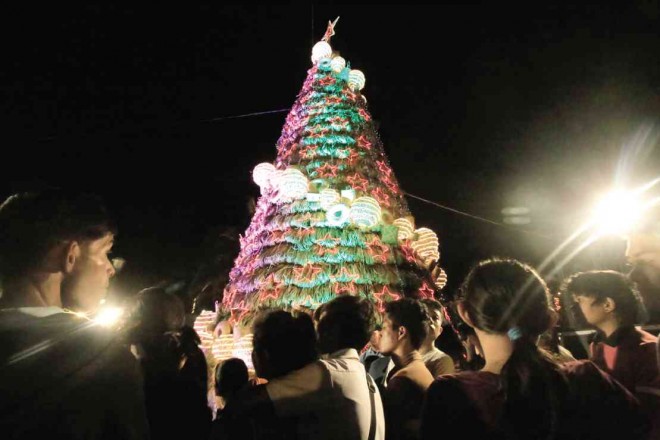
GOING NATIVE The lighting up of the Karagumoy Christmas Tree at PeÒaranda Park in Legazpi City launches the celebration of the sixth Karangahan Albay Green Christmas in Albay province. MARK ALVIC ESPLANA
FOR A PROVINCE deeply involved in disaster preparedness against climate change, Albay has unsurprisingly adopted “Green Christmas” as theme in celebrating this holiday season.
“Having a Christmas tree made of native materials is the best way to address the negative impacts of climate change,” said Gov. Joey Salceda during the lighting of the provincial government’s 36-foot Christmas tree and other displays at Peñaranda Park in Legazpi City on Dec. 1.
The event kicked off the monthlong celebration of Karangahan Festival. The name comes from the Bicol word ranga, meaning endearment, and when it is used to refer to the festival, it means “endearment to culture, arts and nature.”
Salceda said that on its fifth staging, it is about time to showcase one of the most abundant resources of the province—the karagumoy or pandan (Chlorophora excelsa).
Repurposed material
The karagumoy is considered the most ubiquitous craft material in Bicol. Its stripped leaves are used in making mats, hats, the popular bayong baskets and bags, among other items.
Some 3,750 bundles or 937,500 leaves of karagumoy (also called “screw pine” for its pineapple-like leaves in a corkscrew pattern) were used to layer the Christmas tree. LED lights, star lanterns, bags, baskets, decorative balls, hats and other fabrics made of karagumoy adorn the tree.
“It’s very impressive. I can’t imagine karagumoy leaves, which are only used in making bags, will be turned into a gigantic Christmas tree,” said Jay-ar Bombita, 18, a college student from Oas town.
The people of the towns of Bacacay and Sto. Domingo, and Tabaco City have long depended on the karagumoy industry for their livelihood. To underscore the importance of its export-quality products made of fiber from the karagumoy plants that grow abundantly on the island-village of Cagraray, the municipal government of Bacacay celebrates the Karagumoy Festival every August.
Nature themes
Albay’s past holiday themes did not stray far from their significance to local culture, history and economy, and gave focus to the local government’s proenvironment policies.
During the first festival in 2011, the provincial government built a Christmas tree using empty aviation fuel drums donated by the Philippine Air Force Tactical Operations Group-Bicol based in Legazpi, as the Capitol then focused on recycling.
The following year, a tree of pili saplings was erected. Delicacies made of pili nuts are among the most popular products of Albay.
Bicol culture
In 2013, the tree was made of coconut shells in recognition of Bicol as one of the country’s leading coconut producers and the Bicolanos, who are known for their love of all things coconut—particularly the gata (coconut milk) that is present in almost all Bicol dishes, such as the pinangat, laing and Bicol Express.
Last year, the province decided to use kamote (sweet potato) tops to adorn its tree in honor of this humble fare that is abundant locally.
Salceda stressed that the Karangahan Festival was a way of giving importance to local culture, food and the artworks of Albayanos. Throughout the celebration, authentic Bicol dishes will be displayed and sold in stalls set up by local restaurant owners within Peñaranda Park.
“They are all meant to induce and deepen a source of pride in each Albayano while projecting our uniqueness and unity. This is the reason we encourage our constituents, and even our guests, to buy local, eat local, dance local, sing local,” the governor said.
Karangahan “also means a lofty level of endearment and of pride. We care for our people, we hold dear our heritage, we are one in our unique culture, we take pride in the skills of our artists and artisans, and so we share our blessings down to the least fortunate of our brethren,” he said.
Salceda, who has been called a global champion in the fight against climate change, wished to continue to use only recycled and native materials for its annual Christmas tree and displays.
“I believe that this is the best way to act and support the call of Pope Francis’ ‘Laudato Si: Care for Our Common Home,’ our earth and our environment. It is also pursuit in our goal as a province-climate change mitigation and adaptation,” he said.
“We don’t use plastics; we reduce consumption of the earth’s resources, including electricity. We preserve and keep the biosphere clean,” Salceda said.